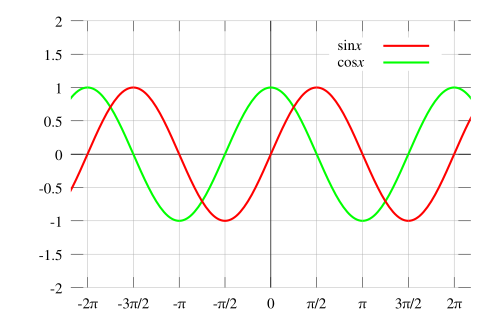A-level Mathematics/OCR/C2/Trigonometric Functions
The Trigonometric Ratios Of An Angle
| Function | Written | Defined | Graph |
|---|---|---|---|
| Cosine | |||
| Sine | |||
| Tangent | 
|
The CAST Model
Important Trigonometric Values
 Below is a table with the common trigonometric values (The circle is labelled with the same values), you need to have these values memorized.
|
The Law of Cosines

Pythagoras theory only applies to right triangles, the law of cosines will apply to any triangle. When you have a right triangle it reduces to the same formula as given by Pythagoras theorem. For any triangle ABC with angle measurement
,
,
and sides of length a,b,c.
Template:TrigBoxOpen
Template:TrigBoxClose
Example
What is the value of c when a = 4 cm, b = 8 cm, and is equal to .
The Law of Sines
For any triangle ABC with angle measurement , , and sides of length a,b,c.
Template:TrigBoxOpen Template:TrigBoxClose
Example If Angle α is , Angle β is and Side b is 3 cm, what is the length of side a?
Area of a Triangle
For any triangle the area is one-half the product of two sides with the sine of the included angle. If the included angle is a right angle, then this reduces to the formula for the area of a right triangle, since
Example:
What is the area of triangle when a = 4 cm, b = 8 cm, and is equal to .
Pythagoras Identity
Template:TrigBoxOpen Template:TrigBoxClose
Proof:
We use the pythagorean theory:
Now we divide by :
We get:
We can write this as:
A good way to think of this of is
A Practical Example
Find all the values of x between 0 rad and 2π rad that satisfy the relationship .
Using the Pythagoras Identity we get:
Now we can simplify:
It is more covinent to replace cos(x) with u:
Then we factor the expression
In order to determine what x is we need to use on our calculators.
But we need to remember that in the interval 2π the cosine function will have the same in 2π - x.
2π rad - 1.2310 rad = 5.0222 rad
2π rad - 1.9823 rad = 4.3009 rad
So the complete answer is 1.2310 rad, 1.9823 rad, 4.3009 rad, and 5.0222 rad.
Tangent Identity
Template:TrigBoxOpen Template:TrigBoxClose
Proof:
Then we can divide both the numerator and the denominator by c
We can write this as:
Example
sin(x) = 4cos(x) solve for sin(x). All units are in radians.
We divide both sides by cos x and we get the identity
tan(x)=4
We use the to get that x = 1.3258 rad.
Now we can solve for sin(x):
sin(x) = 4cos(1.3258 rad) = 4*.2425 rad = .9701 rad .
Template:A-level Mathematics/C2/TOC
pt:Matemática elementar/Trigonometria/Funções trigonométricas


